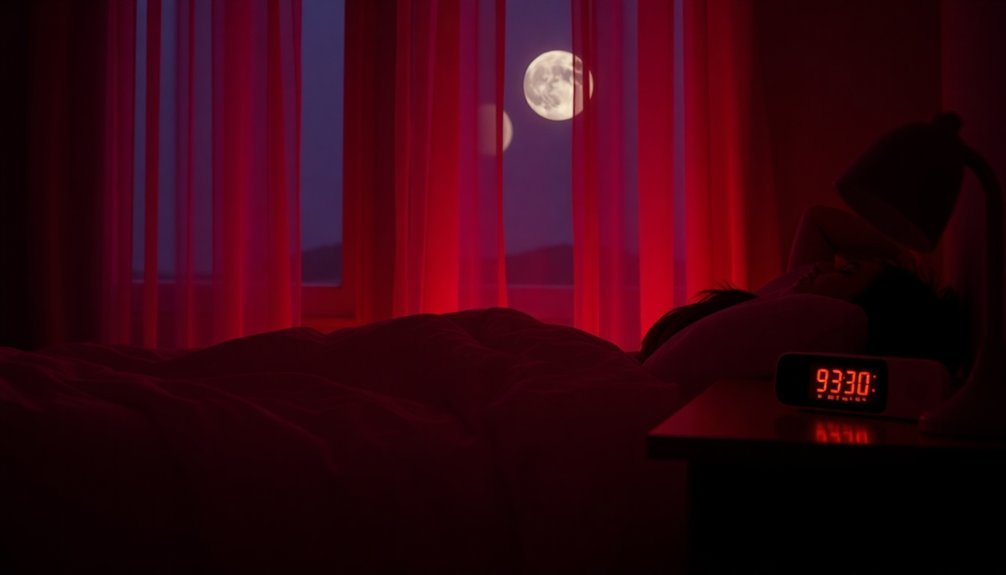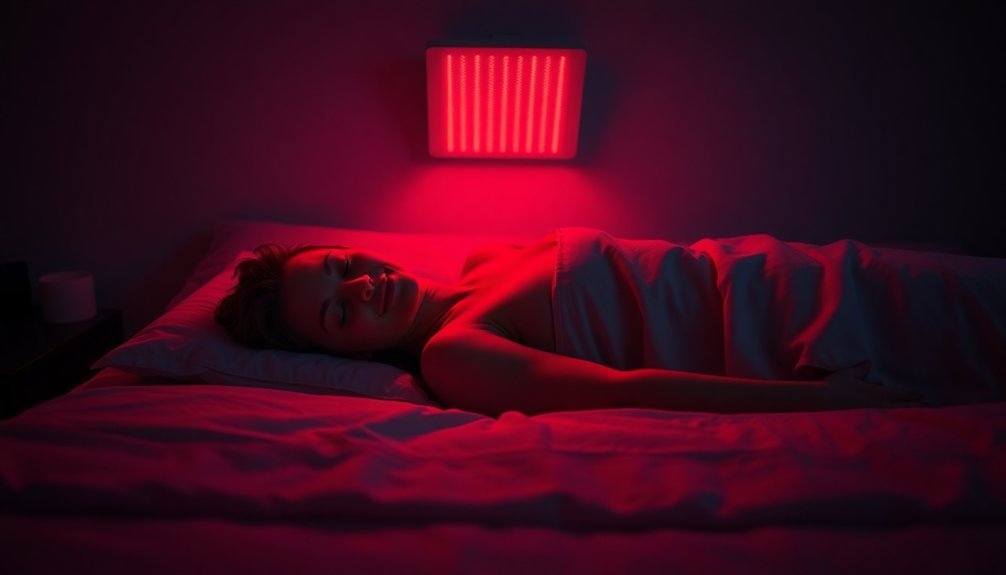Infrared therapy can substantially improve your sleep quality by naturally regulating your body's circadian rhythm. You'll benefit from its ability to stimulate melatonin production while reducing stress hormones like cortisol. Unlike harmful blue light, red light therapy won't disrupt your natural sleep patterns when used in the evening. It's particularly effective at addressing insomnia, sleep apnea, and pain-related sleep disturbances through its ability to promote relaxation and reduce inflammation. For best results, you should use it consistently and time your sessions carefully. Understanding the ideal timing and usage patterns will help you maximize these sleep-enhancing benefits.
Understanding Red Light Sleep Benefits

You'll find that red light therapy's benefits extend beyond just better sleep. It can help reduce symptoms of depression and seasonal affective disorder while providing pain relief. Red light therapy works by stimulating cellular mitochondria, enhancing energy production throughout the body.
This combination of benefits creates ideal conditions for both falling asleep and staying asleep throughout the night, all without the risks associated with UV exposure or other forms of light therapy.
Optimizing Your Sleep Wake Cycle
Through proper timing and consistent exposure, red light therapy can effectively regulate your body's natural sleep-wake cycle. The key lies in understanding how to time your light exposure to align with your body's circadian rhythm and the sun's natural patterns. Most adults require 7 to 9 hours of quality sleep each night to maintain optimal health and wellness.
You'll want to coordinate your therapy sessions with your desired sleep schedule to achieve the best results.
To reset your internal clock, you'll need to combine red light therapy with other proven sleep-enhancing practices. Start by getting natural sunlight exposure in the morning, which helps establish a strong wake signal.
If you're trying to adjust your sleep schedule, you can use red and near-infrared light therapy to either advance or delay your sleep timing. For earlier sleep, schedule your sessions in the morning; for later sleep, use therapy in the evening.
You can maximize these benefits by maintaining consistent sleep and wake times, creating a dark sleeping environment, and avoiding blue light from electronics before bed. Remember that timing is essential – evening exposure should be carefully planned to avoid disrupting melatonin production.
When properly implemented, this combination of light therapy and sleep hygiene practices can markedly improve your sleep-wake cycle.
Stress Relief Through Light Therapy

Red and infrared light therapy stands as a powerful tool for managing stress and anxiety through multiple biological pathways. When you expose yourself to these therapeutic lights, your body responds by decreasing stress hormones like cortisol and ACTH while increasing feel-good chemicals such as endorphins, serotonin, and dopamine.
You'll experience both immediate and long-term benefits from regular light therapy sessions. The treatment helps regulate your body temperature, promoting a natural cooling effect that encourages relaxation. Research shows that light therapy interventions can significantly improve PTSD symptoms and sleep quality.
It's particularly effective when combined with meditation practices, as the light helps calm your nervous system and enhance your meditation experience.
What makes light therapy especially appealing is its non-invasive nature. You won't need medications to achieve stress relief – instead, you'll benefit from the therapy's natural ability to stimulate melatonin production and regulate your circadian rhythms. To maximize these benefits, you'll want to maintain consistent sessions at specific times of day, using appropriate light intensity levels.
The therapy's stress-relieving effects extend beyond mental well-being. As your muscles relax during infrared sessions, you'll likely notice improved sleep quality and reduced physical tension, creating a thorough approach to stress management.
Natural Sleep Enhancement Methods
A peaceful night's rest relies heavily on natural sleep enhancement methods that work in harmony with your body's rhythms. You'll find several effective approaches that can complement your infrared therapy routine, from dietary adjustments to environmental optimizations.
| Natural Aid | How to Use |
|---|---|
| Melatonin | Take 0.5-5mg 30-60 minutes before bed |
| Tart Cherry Juice | Consume 8oz twice daily |
| L-Theanine | Take 200mg before bedtime |
| Valerian Root | Use 300-600mg an hour before sleep |
You can enhance your sleep quality by incorporating glycine-rich foods like beans and spinach into your evening meals. Consider adding bananas or kiwis as a bedtime snack, as they contain sleep-promoting nutrients. When combining these dietary changes with environmental adjustments, you'll create a more effective sleep routine. Adding lavender aromatherapy before bed has been shown to improve sleep quality in people both with and without insomnia.
Make sure you're maintaining a consistent sleep schedule and keeping your bedroom cool and dark. It's essential to limit your screen time before bed, as blue light can disrupt your natural sleep patterns. Regular exercise during the day, but not close to bedtime, will help regulate your sleep cycle and improve overall sleep quality.
Light Treatment Timing Guidelines

Implementing effective light therapy depends heavily on proper timing for your specific sleep disorder. If you're struggling with Delayed Sleep-Wake Phase Disorder, you'll want to use bright light therapy immediately after waking up to help reset your late sleep schedule.
Conversely, if you have Advanced Sleep-Wake Phase Disorder, you should use light therapy in the early evening to delay your early bedtime. To minimize side effects and ensure safety, the light should be positioned indirectly to avoid eye damage.
For jet lag management, the direction of travel determines your treatment timing. When you're heading east, use morning light therapy to advance your body clock; when traveling west, evening light sessions will help delay it.
If you're doing shift work, you'll benefit from evening light exposure while avoiding natural daylight when you're ready to sleep after your shift.
Those with Free-Running Disorder, particularly blind individuals, should focus on early morning light therapy to establish a consistent rhythm.
Timing is more vital than intensity for circadian effects, and you'll get the best results by maintaining regular treatment sessions. For maximum effectiveness, use a light source that provides adequate intensity (10,000 lux) for 20-40 minutes during your designated treatment window.
Frequently Asked Questions
Can Infrared Therapy Help With Sleep Disorders Caused by Chronic Pain Conditions?
Yes, infrared therapy can help you sleep better if you have chronic pain. It'll reduce your pain through vasodilation, decrease inflammation, and boost endorphins, making it easier for you to rest comfortably.
Does the Color Temperature of Room Lighting Affect Infrared Therapy Results?
Based on current research, you won't find that room lighting color temperature affects your infrared therapy results. However, it's worth noting that this specific interaction hasn't been extensively studied in scientific literature yet.
Are There Any Medications That Could Interfere With Infrared Light Therapy?
Yes, you'll need to be careful with several medications. Photosensitizing drugs, immunosuppressants, and some anti-arthritic medications can interfere with or cause adverse reactions during infrared therapy. Always consult your healthcare provider first.
How Long Do Sleep Improvements Last After Stopping Regular Infrared Treatments?
You'll typically experience sleep benefits for several days after stopping infrared treatments, but they'll gradually diminish. The improvements will eventually return to your baseline sleep patterns without continued regular sessions.
Can Infrared Therapy Be Safely Combined With Sleep Supplements Like Melatonin?
You can safely combine infrared therapy with melatonin, but you'll want to consult your healthcare provider first. They work through different mechanisms and may enhance each other's sleep-promoting effects when used together.
In Summary
You'll find infrared therapy to be a valuable tool for improving your sleep quality when used correctly. Time your light exposure strategically, ideally in the evening hours, to help regulate your circadian rhythm. Remember that it's most effective when combined with other healthy sleep habits. While not a cure-all, red light therapy can become part of your natural sleep enhancement routine, helping you drift off more easily.





Leave a Reply